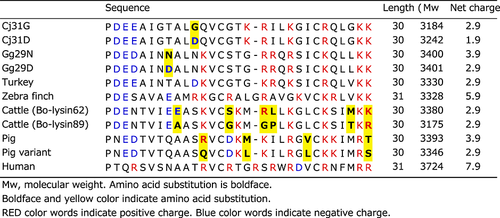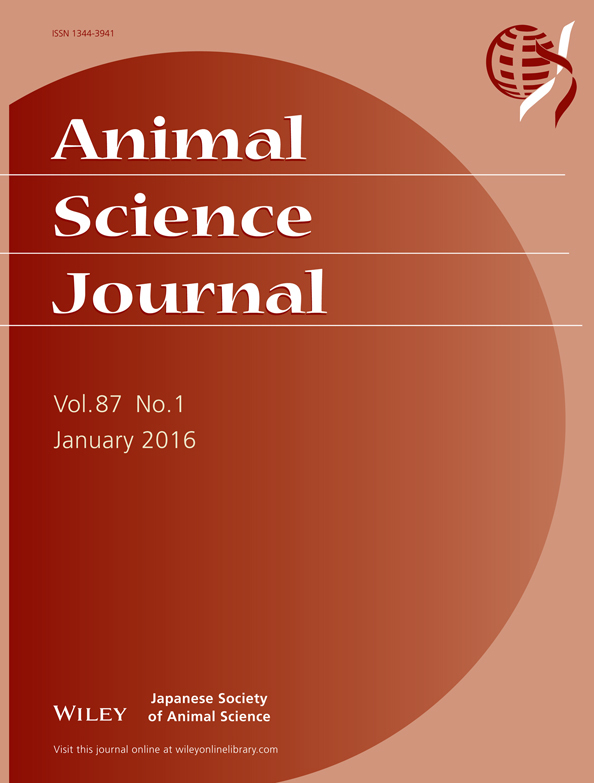Effect of a single polymorphism in the Japanese quail NK-lysin gene on antimicrobial activity
Abstract
NK-lysins are cationic peptides that play important roles in host protection, and are an important constituent of innate immunity. We identified nine single-nucleotide polymorphisms (SNPs) in the NK-lysin open reading frame (ORF) from 32 Japanese quails in six strains: A, B, ND, K, P, and Y. The G to A substitution at nucleotide position 272 in the ORF resulted in a Gly (G) to Asp (D) amino acid substitution (Cj31G and Cj31D alleles). The Cj31D allele was detected in P (frequency 0.76) and Y (frequency 0.03) strains. We compared the antimicrobial activities of four synthetic peptides from the helix 2-loop-helix 3 region of avian NK-lysins against Escherichia coli: Cj31G and Cj31D from quail and Gg29N and Gg29D from chicken. The antimicrobial activities of the four peptides decreased in the following order: Gg29N > Cj31G > Gg29D > Cj31D (P < 0.05). Although there were no differences in the predicted secondary structure of the Cj31G and Cj31D, the net charge of the Cj31G was higher than that of Cj31D. These data indicated that the antimicrobial activity of CjNKL is influenced by net charge, similar to that which has been observed in chicken. © 2015 Japanese Society of Animal Science
Introduction
NK-lysin (NKL) is a cationic antimicrobial peptide that was originally isolated from porcine intestinal tissue (Andersson et al. 1995). NKL is orthologous to granulysin, and was found in the granules of T lymphocytes and natural killer (NK) cells. The structure and antimicrobial activity of NKL from various vertebrates have been reported. Among avian species, NKL has been identified in: chicken, GgNKL (Hong et al. 2006); turkey, MgNKL (Dalloul et al. 2010); zebra finch, TgNKL (Warren et al. 2010); and Japanese quail, CjNKL (Ishige et al. 2014). In chicken, GgNKL has been mapped to chromosome 22 (Lee et al. 2014), and was shown to have antimicrobial activity against coccidians (Hong et al. 2008), and Gram-positive and -negative bacteria (Hong et al. 2006; Lee et al. 2012). It also has antitumor activity (Lee et al. 2012).
The helix 2-loop-helix 3 structure is an important region for the antimicrobial activity of NKL (antimicrobial region: 30~31 aa, Li et al. 2005 and Lee et al. 2012). In mammals, polymorphism of NKL and granulysin has been demonstrated in pigs (Andersson et al. 1995), cattle (Endsley et al. 2004), and humans (Ericson et al. 2003). In pig and cattle NKLs, amino acid substitutions with net charge were located in the antimicrobial region, but the relationship between net charge and antimicrobial activity has not been discussed. However, it has been reported that the net charge of NKL is correlated with antimicrobial activity against Gram-negative bacteria (Andrä et al. 2007). Furthermore, in GgNKL, a close relationship was reported between amino acid substitution and a change in net charge in the antimicrobial region (N29D) and antimicrobial and antitumor activities (Lee et al. 2012).
In the present study, we identified an amino acid substitution in the antimicrobial region of CjNKL and suggest that this variation is associated with a change in antimicrobial activity.
Materials and Methods
Animal care
The management of Japanese quails and all procedures in the present study were performed in accordance with the Animal Experimental Guidelines for Tokyo University of Agriculture.
Japanese quail
A total of 76 adult quails from among six strains - five A (high-immunoglbulin G (IgG)), seven B (low-IgG), 19 K (dark), four ND (neuron disease), 25 P (Panda), and 16 Y (yellow) - were maintained in the Laboratory of Animal Physiology, Tokyo University of Agriculture (Suzuki et al. 2013).
Nucleic acid isolation
Peripheral blood samples were collected from the jugular veins of quails. Genomic DNA was isolated from the peripheral red blood cells using a standard phenol-chloroform extraction.
Amplification of genomic fragments of CjNKL
The quail genomic DNA templates were PCR amplified using the primer pair forward 5′-GCGGGCAACAAACAAACCAA-3′ (upstream CjNKL) and reverse 5′-CCCCCGCAGCCAAATAAAAC-3′ (downstream CjNKL), which were designed based on CjNKL sequences (Accession No. AB787179). The PCR program used was as follows: 98°C denaturation for 2 min, followed by 32 cycles of denaturation at 98°C for 10 sec, annealing and extension at 68°C for 60 sec. The reaction amplified products of 1.4 kbp.
Single-nucleotide polymorphism (SNP) analysis
For nucleotide sequencing, direct sequencing of the PCR products was performed by the cycle sequencing method, using a Big Dye Terminator Cycle Sequencing kit (ABI ver. 3.1; Applied Biosystems, Foster City, CA, USA), and an automated capillary fluorescent DNA sequencing machine (ABI Prism 3130; Applied Biosystems). The sequences of CjNKL were aligned using ClustalW and the allele was identified.
Prediction of the secondary structure of the antimicrobial region
The secondary structure of the antimicrobial region was predicted using the Jpread server (Cole et al. 2008).
Antimicrobial region peptide synthesis
Gg29N and Gg29D were designed based on the amino acid substitution D29N located in the antimicrobial region of the chicken GgNKL (Lee et al. 2012) (Fig. 1). The peptides Cj31G and Cj31D were designed from two peptides isolated in the antimicrobial region of quail CjNKL in this experiment based on the amino acid substitution D31G (Fig. 1). All four peptides were synthesized by the Funakoshi Corporation, and all had over 90% purity. Lyophilized peptides were stored in desiccant at -20°C, and dissolved in dimethyl sulfoxide (DMSO) and diluted in 10 mmol/L phosphate buffer (pH 7.2) before use.
Antimicrobial assay
Escherichia coli (NRIC 1023) was provided by the Nodai Culture Collection Center and was used to measure the antimicrobial activity of Cj31G, Cj31D, Gg29N and Gg29D. Following an overnight incubation at 37°C, the E. coli cells were subcultured for an additional 2 h at 37°C to the mid-logarithmic phase. Cultured E. coli cells were washed once with 10 mmol/L phosphate buffer (pH 7.2) and suspended to a concentration of 1 × 104 colony-forming units (CFU)/mL in the same buffer. Ninety microliters of the E. coli suspension was placed in 0.2-mL tubes, followed by the addition of 10 μL of serially diluted peptides in triplicate. After a 3-h incubation at 37°C, the cultures were plated onto LENNOX L BROTH agar, incubated overnight at 37°C and then the numbers of surviving bacterial colonies were counted.
Statistical analyses
A χ2 test for goodness of fit was used to verify whether the observed allele frequencies based on SNPs in the CjNKL antimicrobial region agreed with those expected under Hardy-Weinberg equilibrium. Antimicrobial activity was analyzed using a one-way analysis of variance followed by the Holm-Bonferroni method for unpaired data. Differences with P < 0.05 were considered statistically significant.
Results and Discussion
SNPs in the CjNKL coding sequence
Three allelic variants of the nucleotide sequences from the CjNKL locus - 901-bp (Accession No. LC016562), 921-bp (LC016563), and 961-bp (LC016564) - were identified in 32 quails that were CjNKL homozygous based on nine SNPs in exons (four synonymous and five nonsynonymous), and 11 SNPs and 20- or 60-bp insertion-deletions in intron 1 (Fig. S1). The SNP at nucleotide position 272 (G272A) in the open reading frame was located in the antimicrobial region. This nonsynonymous SNP corresponded to position 31 (Gly 31 Asp, G31D) in the CjNKL mature peptide but had altered polarity. G31D is assumed to be associated with antimicrobial activity, since an amino acid substitution (N29D) in the antimicrobial region of GgNKL resulted in a change of polarity and antimicrobial activity (Lee et al. 2012). Only one polymorphism (G272A) was found in the other 44 quails examined. A, B, K and ND strains contained only 272G, whereas both 272G and 272A were identified from strains P and Y. In strain P, the frequency of 272A (0.76) was higher than that of 272G (0.24) and the χ2 value (for Hardy-Weinberg equilibrium) was 0.280 (P > 0.8). In strain Y, the frequency of 272A (0.03) was notably lower than that of 272G (0.97) and the χ2 value was 0.020 (P > 0.99).
Antibacterial activity of NKL synthetic peptides
None of the synthetic peptides at concentrations of 1 and 10 µmol/L had antimicrobial activity against E. coli. The antimicrobial activities of 100 and 1000 µmol/L Cj31G were significantly higher than those of Cj31D (P < 0.05) (Table 1). The antimicrobial activity of Gg29N was higher than that of Gg29D (Table 1), which is consistent with the observations reported by Lee et al. (2012). The antimicrobial activity of Cj31D was the lowest among that of the four synthesized peptides (Table 1).
| Peptide concentration (µmol/L) | ||||
|---|---|---|---|---|
| Peptide | 1 | 10 | 100 | 1000 |
| Cj31D | 94.7±15.1 | 111±5.9 | 112±2.8d | 14±1.8b |
| Cj31G | 102±9.0 | 117±3.3 | 35±2.8b | 0a |
| Gg29D | 94.4±2.8 | 94.4±5.8 | 99±6.1c | 0a |
| Gg29N | 102±6.2 | 95±5.0 | 0a | 0a |
- a-d Means within the same row with different superscripts differ (a < b < c <d, P < 0.05). Results are presented as means ± standard error of the mean (n = 3).
The predicted secondary structure of Cj31D was the same as that of Cj31G (Fig. S2). However, there were differences in the length of helix2, which descended in the following order: Gg29N > Gg29D > Cj31G = Cj31D (Fig. S2).
There were differences in the net charge, which decreased in the following order: Gg29N > Cj31G = Gg29D > Cj31D (Fig. 1). Lee et al. (2012) reported that the antimicrobial activity of Gg29D was lower than that of Gg29N due to the lower net charge of the former. In pigs, the net charge of variant NKL was lower than that of wild-type NKL (Fig. 1), and the antimicrobial activity of variant NKL against E. coli tended to be lower than that of wild-type NKL (Andersson et al. 1995). Furthermore, it has been reported that the net charge of NKL is correlated with antimicrobial activity against Gram-negative bacteria (Andrä et al. 2007). It is therefore suggested that the antimicrobial activity of Cj31D might be lower than that of Cj31G due to its lower net charge.

These results suggest that the antimicrobial activity of CjNKL is influenced by the net charge of the antimicrobial region, as in GgNKL. Since the antimicrobial activity of Cj31G was higher than that of Cj31D, it is suggested that antimicrobial activity in 272G CjNKL will be higher than that in 272A CjNKL. The net charge of the zebra finch NKL antimicrobial region is the highest among the NKLs of other avian species, suggesting that the antimicrobial activity of zebra finch NKL is the highest among the NKLs of other avian species.
Conclusion
We identified a nonsynonymous SNP in the antimicrobial region of quail NK-lysin. Of the two synthetic peptides designed from the antimicrobial region, Cj31G had greater antimicrobial activity against E. coli than did Cj31D. Differences in the antimicrobial activities of Cj31G and Cj31D are suggested to be correlated with a difference in net charge, which has also been observed in chicken GgNKL.
Acknowledgments
This research was supported in part by the Advanced Research Project Type A, Tokyo University of Agriculture (No.02, 2006-2008), and MEXT-Supported Program for the Strategic Research Foundation at Private Universities, 2013-2017 (S1311017).




